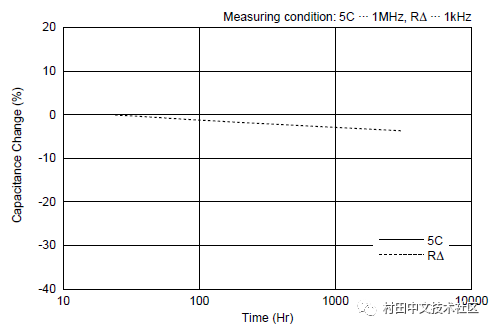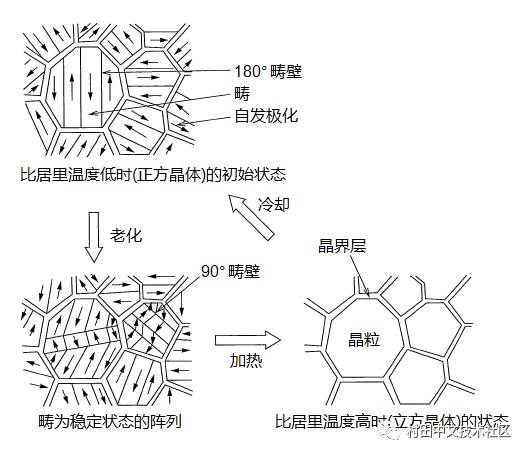Among ceramic capacitors, especially high-capacitance series capacitors (B/X5R, R/X7R characteristics), the electrostatic capacitance decreases with time. When used in a clock circuit or the like, this characteristic should be fully considered and confirmed on actual use conditions and actual use equipment. For example, as shown in the figure below, the longer the elapsed time, the lower the actual electrostatic capacity. (The linear linearity decreases on the logarithmic time chart) * The horizontal axis of the graph below shows the operating time (Hr) of the capacitor, and the vertical axis shows the graph of the rate of change of the electrostatic capacitance with respect to the initial value. As shown in the figure, the characteristic that the electrostatic capacity decreases with time is referred to as the temporal change (aging) of the electrostatic capacity. In addition, the aging characteristics are not limited to Murata products, and are present in all high-inductance type capacitors, and there is no aging characteristic in the temperature compensation capacitor. In addition, when the capacitor whose electrostatic capacitance is reduced due to aging is heated to a Curie temperature (about 125 ° C) or higher due to a welding operation or the like in the process, the electrostatic capacitance is restored. Moreover, when the capacitor temperature drops below the Curie temperature, aging will begin again. Principles of aging characteristics High-capacitance series capacitors in ceramic capacitors now mainly use a dielectric containing BaTiO3 (barium titanate) as a main component. BaTiO3 has a perovskite-like crystal structure as shown in the figure below. When it is above the Curie temperature, it is a cubic crystal, Ba2+ ions are at the apex, O2- ions are at the center of the surface, and Ti4+ ions are at the center of the cube. position. The above figure is a cubic crystal structure at a Curie temperature (about 125 ° C) or higher. In the normal temperature range below this temperature, it is a one-axis (C-axis) elongation, and the other axes are slightly shortened. Tetragonal) crystal structure. At this time, as Ti4+ ions are shifted in the direction in which the crystallization unit is elongated, polarization is generated. However, this polarization is generated even in the absence of an external electric field or voltage, and therefore, it is called spontaneous polarization. (spontaneous polarization). As described above, the characteristic of spontaneous polarization and the ability to change the orientation of spontaneous polarization according to an external electric field is specifically referred to as a strong induction type. (The rhombohedral system is sometimes called a trigonal system, and the orthorhombic system is called a monoclinic system.) In addition, when BaTiO3 is heated above the Curie temperature, the crystal structure will undergo phase transfer from the tetragonal crystal to the cubic crystal. The spontaneous polarization will disappear with this change, and the domains will also not exist. When it is cooled below the Curie temperature, phase transition occurs from the cubic crystal to the tetragonal crystal near the Curie temperature, and the C-axis direction will be extended by about 1%, the other axes will be slightly shortened, and spontaneous polarization and domains will be generated. . At the same time, the crystal grains will be subjected to pressure due to deformation. At this time, a plurality of minute domains are generated in the crystal grains, and the spontaneous polarization of each domain is in a state in which phase transition easily occurs even in the case of a low electric field. If placed below the Curie temperature and placed in an unloaded state, the domains that are generated in a random direction will have a larger size over time and will gradually proceed toward a more stable form of energy (Fig. 90° domain). Arrange again to release the pressure due to deformation of the crystal. In addition to this, the space charge of the grain boundary layer (slow moving ions and void points, etc.) will move and generate polarization of space charge. The polarization of the space charge will act on spontaneous polarization, hindering the phase transition of spontaneous polarization. Therefore, the spontaneous polarization gradually recombines with the spontaneous polarization becoming stable from the beginning of the generation, and at the same time, the space charge polarization occurs in the grain boundary layer, and the phase transition of spontaneous polarization is made. Obstructed. In this state, in order to phase-transform the spontaneous polarization of each domain, a stronger electric field is required. The same as the phase transition of spontaneous polarization per unit volume is the permittivity, so if the domain in which the phase transition occurs under a weak electric field is reduced, the electrostatic capacity will decrease. Portable Battery ,Portable Power Bank,Portable Battery Pack,Portable Power Pack Zhejiang Casnovo Materials Co., Ltd. , https://www.casnovonewenergy.com


